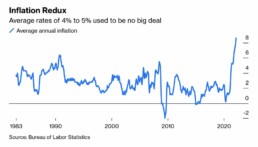What is E-commerce Inflation?
Despite the fact that inflation has not been significant for e-commerce throughout its history, everything changed at the start of the pandemic in 2020. Since then, inflation, shortages, and supplies have only become worse, impacting most e-commerce businesses around the world.
According to the July 2021 Report by Adobe Digital Economy Index, online prices have increased 3.1% YoY.
“In January and February 2022, these higher costs drove $3.8 billion in online sales growth. That same rate of inflation could lead consumers to spend nearly $27 billion more in 2022 on the same amount of purchases.”
Retail Dive
To some degree, the rate of e-commerce inflation has matched the general rate of economic inflation, which was recorded at 8.5% in April 2022.
“Consumers and e-commerce alike should anticipate inflation to linger around 4-5% over the next three years.”
Bloomberg

How is Inflation Affecting E-commerce?
While e-commerce is experiencing an all-time high in sales growth, inflation is not linear. It ripples through the economy in various ways, affecting nearly every e-commerce differently. Inflation’s impact on small to medium-sized businesses may seem negligible now, but it can quickly add up with ongoing obstacles in the supply chain.
When manufacturers are unable to retrieve the raw materials required to produce products, they suffer. Additionally, inflation increases the price of other commodities such as electricity, internet, online advertising, and computer upkeep. From reduced inventory and missing items to increased costs and longer delays, inflation is affecting businesses around the world.
Raising prices makes sense for most businesses combatting the effects of inflation. However, charging more could cause additional chain reactions. Because inflation reduces the number of products consumers can afford, we predict a heavy impact on e-commerce, especially those selling non-essential or luxury items. When consumers restrict their spending habits, businesses naturally lose profitability.
Covid and the Supply Chain
The increased demand for products rather than services reflects the significant shift in consumer behavior since the pandemic. This unanticipated demand, combined with the effects of Covid-19, had a significant impact on the already stressed supply chain.
“The shipping delays and port bottlenecks of late 2021 left businesses with insufficient supply. At the same time, Americans unleashed pent-up demand throughout last year and pushed spending above the pre-pandemic trend.”
Business Insider
What Can E-commerce Do?
Although the supply chain is slowly recovering, what can you do to combat growing prices, reduced inventory, and future shortages?
Update Product Offering
Is your product model reflecting the current market inflation? If it doesn’t, try to eliminate underperforming SKUs, introduce private label brands, and combine items to boost the value or lower product amounts. For example, instead of a 10-ounce portion, provide an 8-ounce.
Increase Productivity
Increasing productivity may be an alternative to raising prices. Some examples of how to increase productivity are; the use of automation, marketing optimization, recruiting personnel, or utilizing a third-party fulfillment service to find you the best avenues to navigate inflation and fulfillment.
Keep a Safety Stock
Extended lead times, increased prices, and the unpredictability of the supply chain, has made maintaining healthy inventory levels more important than ever. If your position allows, we recommend keeping up to six months’ worth of safety stock on hand. This may help e-commerce capitalize on additional market share during future times of inflation, delays, or shortages. For businesses that are forced to overlook this strategy, partnering with a 3PL could be the answer to reliable safety stock and affordable warehousing.
Switch Suppliers
Working with a manufacturer that can build and ship your items locally can save on high sea freight shipping costs. Most sellers find the efficiency and cost of manufacturing in China to be appealing; however, spending more on local production may prove to be a justifiable tradeoff when avoiding high and continuously climbing sea freight costs. Transitioning to a domestic supplier allows you to minimize supply chain complications and provide home-grown products to consumers.
Beginner’s Guide to Third-Party Logistics (3PL)
The world of e-commerce is always changing, therefore understanding the roll of Third-Party Logistics is integral to keeping up. In light of this our beginner’s guide to third-party logistics (3PL) will delve into the essential aspects, offering insights into fulfillment services, warehousing, and much more.
Read More…
Despite best efforts, e-commerce companies may still have to raise prices due to inflation. However, leveraging these tips could help your e-commerce business keep costs lower, which will maximize your competitive advantage.





